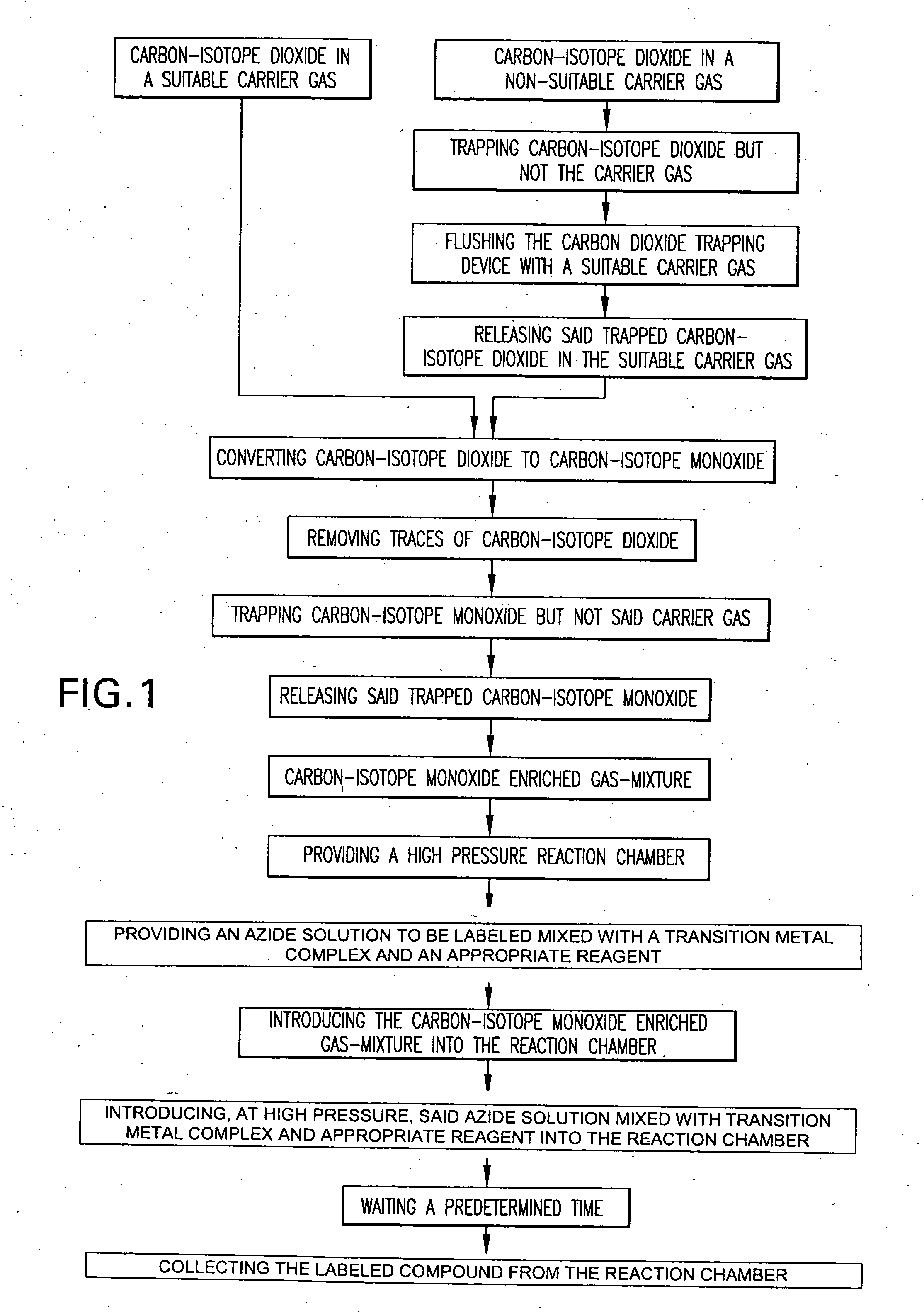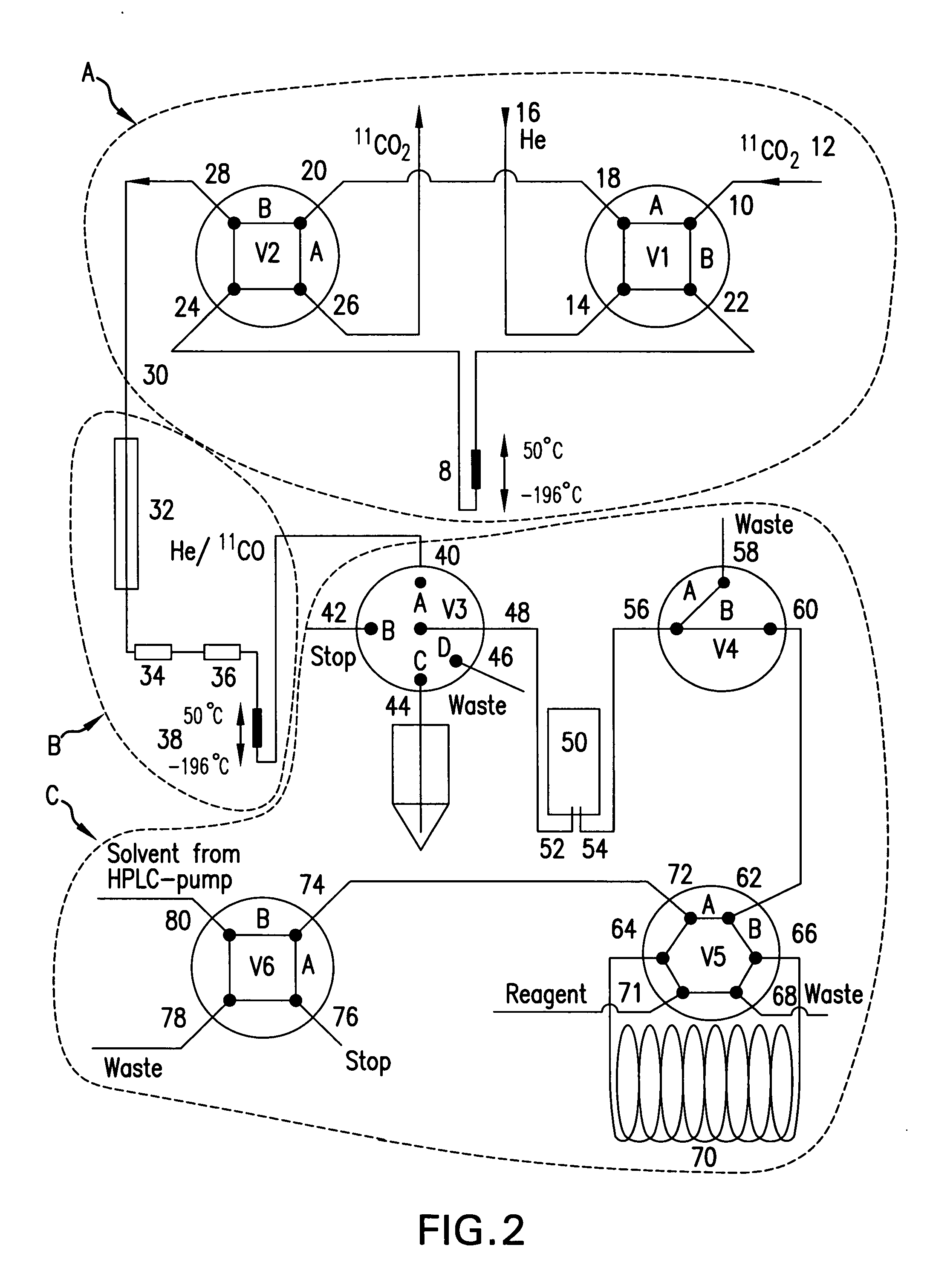Methods for carbon isotope labeling synthesis by transition metal-promoted carbonylation via isocyanate using azides and carbon-isotope monoxide
a carbon isotope and isocyanate technology, which is applied in the direction of carbamic acid derivative preparation, organic chemistry, therapy, etc., can solve the problems of low reaction media trapping efficiency, low level of specific radioactivity, and unfavorable pet tracer production. achieve the effect of high level of radioactivity
- Summary
- Abstract
- Description
- Claims
- Application Information
AI Technical Summary
Benefits of technology
Problems solved by technology
Method used
Image
Examples
example 1
Experimental Setup
[0120] [11C]Carbon dioxide production was performed using a Scanditronix MC-17 cyclotron at Uppsala IMANET. The 14N(p,α)11C reaction was employed in a gas target containing nitrogen (Nitrogen 6.0) and 0.1% oxygen (Oxygen 4.8) which was bombarded with 17 MeV protons.
[0121] [11C]Carbon monoxide was obtained by reduction of [11C]carbon dioxide as described in the instant application.
[0122] The syntheses with [11C]carbon monoxide were performed with an automated module as part of the system “Synthia 2000”. [11C] carbon dioxide was trapped on a column (Porapac Q) at −196° C. and released by heating and reduced during its passage through a zinc filled tube at 400° C. HPLC analysis was performed with a Beckman 126-gradient pump and a Beckman 166 variable wavelength UV-detector in series with a β+-flow detector. The analytical column was a Beckman Ultrasphere ODS C18 (250×4.6 mm id). Data collection and LC control were performed using a Beckman System Gold chromatograph...
example 2
Synthesis of 11C-Labeled Diphenylurea and 11C-Labeled Ethyl Phenylcarbamate
[0123] The general reaction scheme is illustrated as follows:
example 2a
Synthesis of 11C-Labeled Diphenylurea
[0124] In a capped vial (1 mL) containing a solution of phenylazide (6.6 mg, 55 μmol) in dry THF (300 μL), was added [RhCl(cod)]2 (0.27 mg, 0.55 μmol), and 1,2-bis(diphenylphosphino)ethane (0.44 mg, 1.1 μmol) and was shaken until the solution was homogeneous. After addition of aniline (10 μL, 110 μmol), the resulting mixture was transferred to the micro-autoclave, which was pre-charged with [11C]CO. The autoclave (250 μL) was heated at 120° C. for 5 min under 35 MPa and the crude product was transferred to a reduced pressure vial. The radioactivity was measured before and after the vial was flushed with N2 (the [11C]CO-trapping efficiency of 82% was determined based on these values). A small amount of crude product was collected and analyzed by the reversed phase HPLC. Yield of product: 82%. The product was identified by HPLC with an added authentic reference compound.
PUM
| Property | Measurement | Unit |
|---|---|---|
| pressure | aaaaa | aaaaa |
| temperatures | aaaaa | aaaaa |
| temperatures | aaaaa | aaaaa |
Abstract
Description
Claims
Application Information
 Login to View More
Login to View More - R&D
- Intellectual Property
- Life Sciences
- Materials
- Tech Scout
- Unparalleled Data Quality
- Higher Quality Content
- 60% Fewer Hallucinations
Browse by: Latest US Patents, China's latest patents, Technical Efficacy Thesaurus, Application Domain, Technology Topic, Popular Technical Reports.
© 2025 PatSnap. All rights reserved.Legal|Privacy policy|Modern Slavery Act Transparency Statement|Sitemap|About US| Contact US: help@patsnap.com



